Comprehensive Report: Education and Training Policy and Practice
VerifiedAdded on 2020/11/23
|12
|3985
|328
Report
AI Summary
This report delves into the core concepts of education and training, examining professionalism and dual professionalism, and how professional values influence teaching practices. It analyzes the impact of social, political, and economic factors on education policy, providing insights into current UK educational policies such as free elementary education and comprehensive education. The report further explores the roles of stakeholders and external bodies in education, their impact on curriculum design, delivery, and assessment, and the importance of partnerships with employers. It also presents key policies, codes of practice, and guidelines affecting teachers and educational organizations, and concludes with an evaluation of quality improvement and assurance arrangements, including self-assessment and areas for improvement in learning programs. The content is contributed by a student and is available on Desklib, a platform providing AI-based study tools.
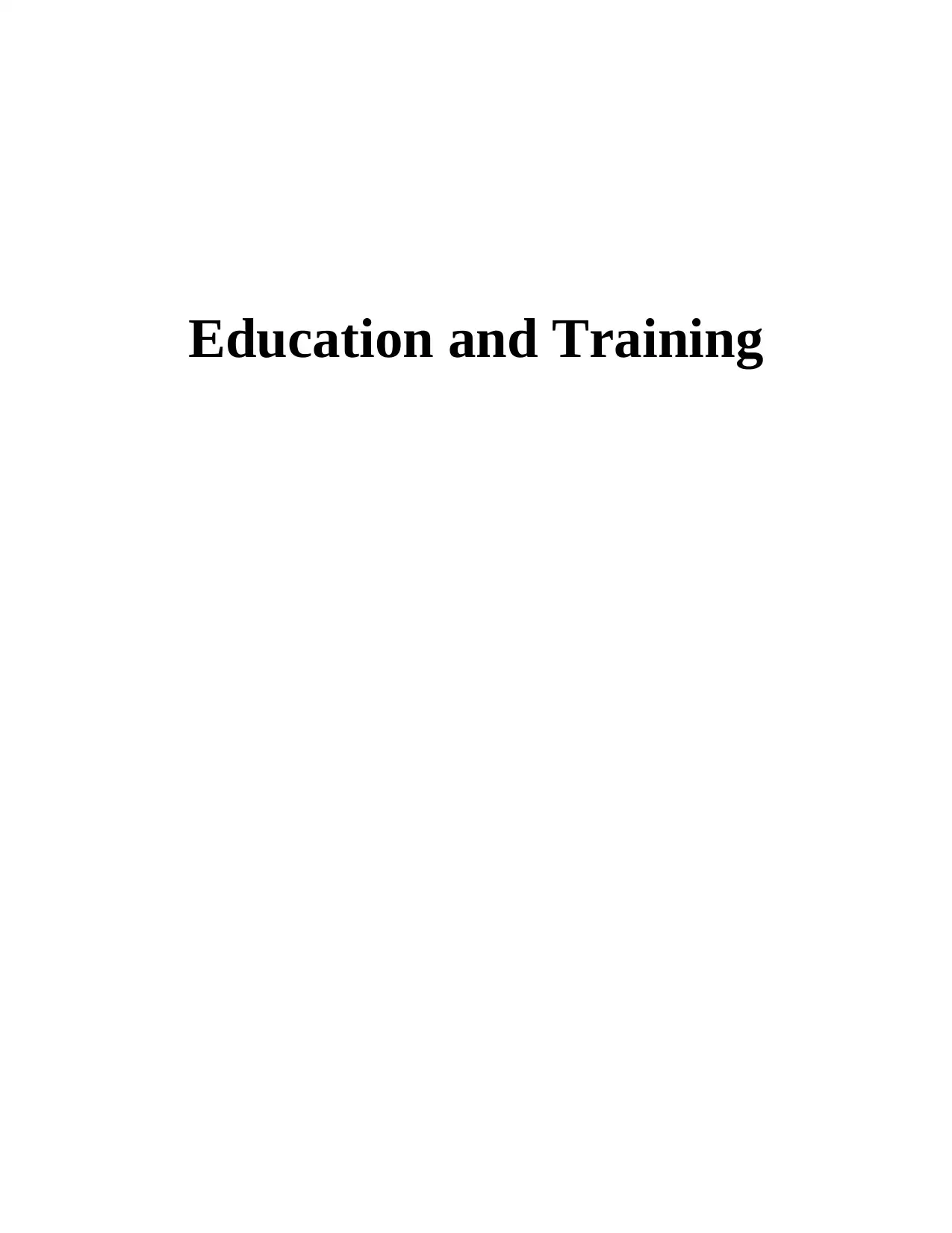
Education and Training
Secure Best Marks with AI Grader
Need help grading? Try our AI Grader for instant feedback on your assignments.
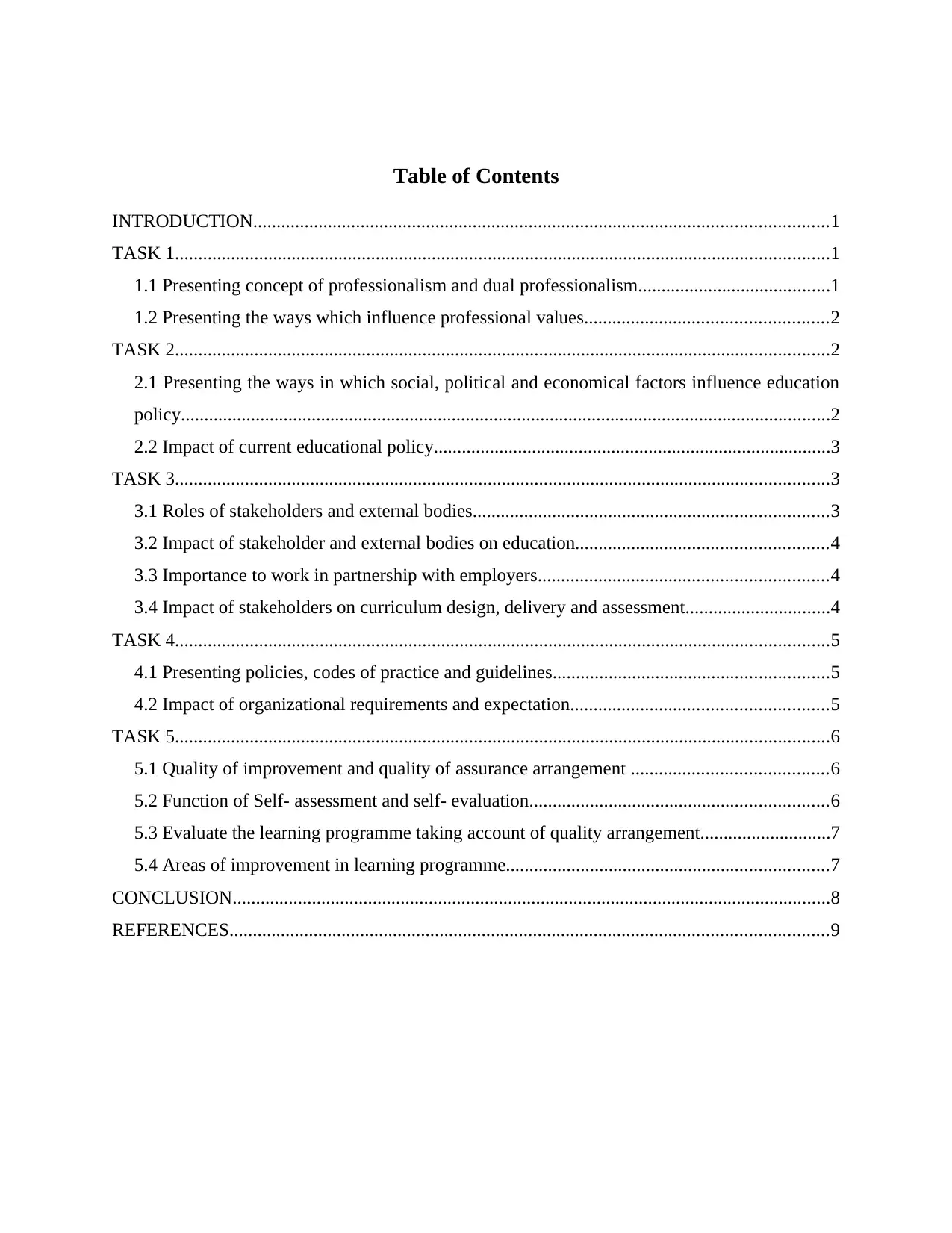
Table of Contents
INTRODUCTION...........................................................................................................................1
TASK 1............................................................................................................................................1
1.1 Presenting concept of professionalism and dual professionalism.........................................1
1.2 Presenting the ways which influence professional values....................................................2
TASK 2............................................................................................................................................2
2.1 Presenting the ways in which social, political and economical factors influence education
policy...........................................................................................................................................2
2.2 Impact of current educational policy.....................................................................................3
TASK 3............................................................................................................................................3
3.1 Roles of stakeholders and external bodies............................................................................3
3.2 Impact of stakeholder and external bodies on education......................................................4
3.3 Importance to work in partnership with employers..............................................................4
3.4 Impact of stakeholders on curriculum design, delivery and assessment...............................4
TASK 4............................................................................................................................................5
4.1 Presenting policies, codes of practice and guidelines...........................................................5
4.2 Impact of organizational requirements and expectation.......................................................5
TASK 5............................................................................................................................................6
5.1 Quality of improvement and quality of assurance arrangement ..........................................6
5.2 Function of Self- assessment and self- evaluation................................................................6
5.3 Evaluate the learning programme taking account of quality arrangement............................7
5.4 Areas of improvement in learning programme.....................................................................7
CONCLUSION................................................................................................................................8
REFERENCES................................................................................................................................9
INTRODUCTION...........................................................................................................................1
TASK 1............................................................................................................................................1
1.1 Presenting concept of professionalism and dual professionalism.........................................1
1.2 Presenting the ways which influence professional values....................................................2
TASK 2............................................................................................................................................2
2.1 Presenting the ways in which social, political and economical factors influence education
policy...........................................................................................................................................2
2.2 Impact of current educational policy.....................................................................................3
TASK 3............................................................................................................................................3
3.1 Roles of stakeholders and external bodies............................................................................3
3.2 Impact of stakeholder and external bodies on education......................................................4
3.3 Importance to work in partnership with employers..............................................................4
3.4 Impact of stakeholders on curriculum design, delivery and assessment...............................4
TASK 4............................................................................................................................................5
4.1 Presenting policies, codes of practice and guidelines...........................................................5
4.2 Impact of organizational requirements and expectation.......................................................5
TASK 5............................................................................................................................................6
5.1 Quality of improvement and quality of assurance arrangement ..........................................6
5.2 Function of Self- assessment and self- evaluation................................................................6
5.3 Evaluate the learning programme taking account of quality arrangement............................7
5.4 Areas of improvement in learning programme.....................................................................7
CONCLUSION................................................................................................................................8
REFERENCES................................................................................................................................9
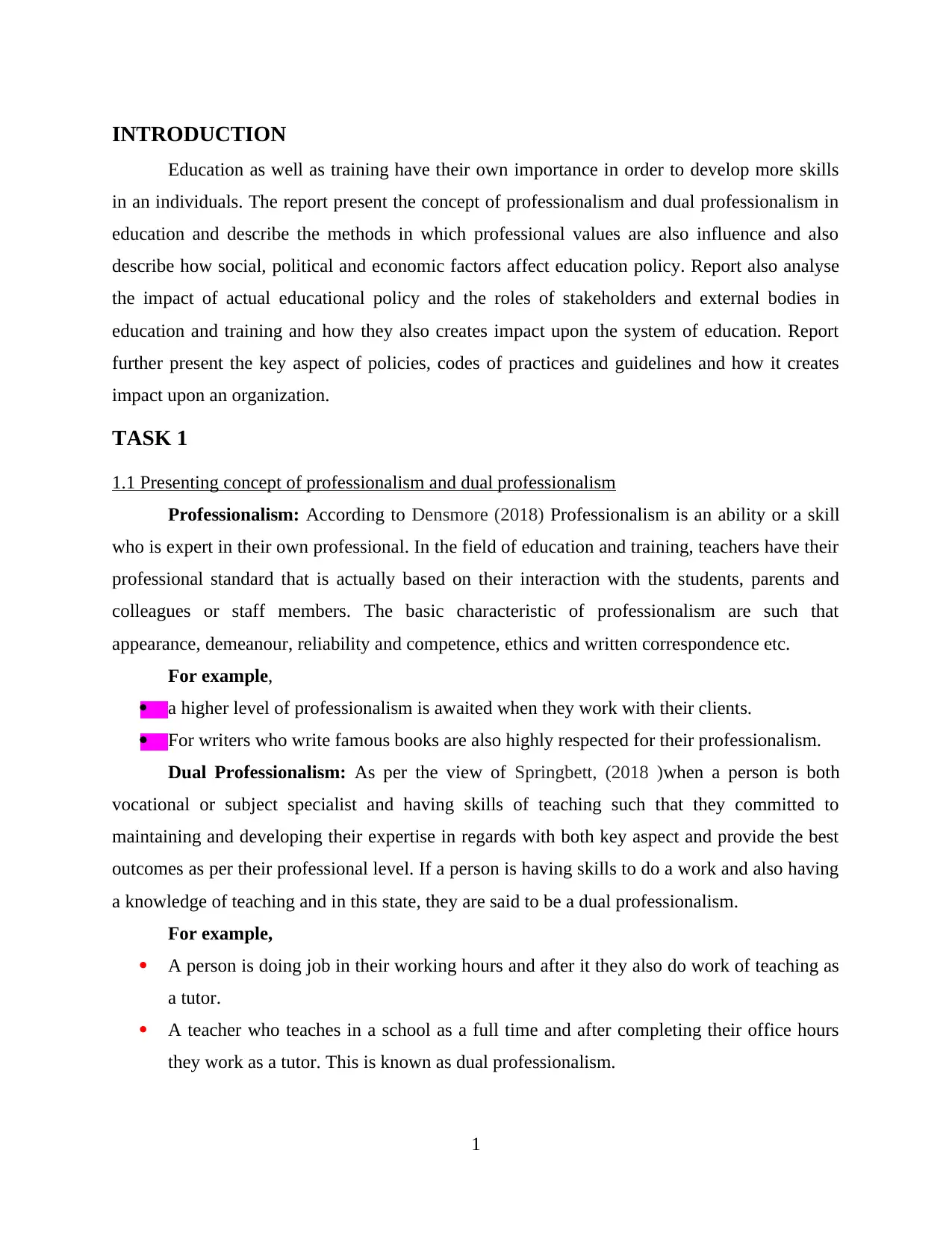
INTRODUCTION
Education as well as training have their own importance in order to develop more skills
in an individuals. The report present the concept of professionalism and dual professionalism in
education and describe the methods in which professional values are also influence and also
describe how social, political and economic factors affect education policy. Report also analyse
the impact of actual educational policy and the roles of stakeholders and external bodies in
education and training and how they also creates impact upon the system of education. Report
further present the key aspect of policies, codes of practices and guidelines and how it creates
impact upon an organization.
TASK 1
1.1 Presenting concept of professionalism and dual professionalism
Professionalism: According to Densmore (2018) Professionalism is an ability or a skill
who is expert in their own professional. In the field of education and training, teachers have their
professional standard that is actually based on their interaction with the students, parents and
colleagues or staff members. The basic characteristic of professionalism are such that
appearance, demeanour, reliability and competence, ethics and written correspondence etc.
For example,
a higher level of professionalism is awaited when they work with their clients.
For writers who write famous books are also highly respected for their professionalism.
Dual Professionalism: As per the view of Springbett, (2018 )when a person is both
vocational or subject specialist and having skills of teaching such that they committed to
maintaining and developing their expertise in regards with both key aspect and provide the best
outcomes as per their professional level. If a person is having skills to do a work and also having
a knowledge of teaching and in this state, they are said to be a dual professionalism.
For example,
A person is doing job in their working hours and after it they also do work of teaching as
a tutor.
A teacher who teaches in a school as a full time and after completing their office hours
they work as a tutor. This is known as dual professionalism.
1
Education as well as training have their own importance in order to develop more skills
in an individuals. The report present the concept of professionalism and dual professionalism in
education and describe the methods in which professional values are also influence and also
describe how social, political and economic factors affect education policy. Report also analyse
the impact of actual educational policy and the roles of stakeholders and external bodies in
education and training and how they also creates impact upon the system of education. Report
further present the key aspect of policies, codes of practices and guidelines and how it creates
impact upon an organization.
TASK 1
1.1 Presenting concept of professionalism and dual professionalism
Professionalism: According to Densmore (2018) Professionalism is an ability or a skill
who is expert in their own professional. In the field of education and training, teachers have their
professional standard that is actually based on their interaction with the students, parents and
colleagues or staff members. The basic characteristic of professionalism are such that
appearance, demeanour, reliability and competence, ethics and written correspondence etc.
For example,
a higher level of professionalism is awaited when they work with their clients.
For writers who write famous books are also highly respected for their professionalism.
Dual Professionalism: As per the view of Springbett, (2018 )when a person is both
vocational or subject specialist and having skills of teaching such that they committed to
maintaining and developing their expertise in regards with both key aspect and provide the best
outcomes as per their professional level. If a person is having skills to do a work and also having
a knowledge of teaching and in this state, they are said to be a dual professionalism.
For example,
A person is doing job in their working hours and after it they also do work of teaching as
a tutor.
A teacher who teaches in a school as a full time and after completing their office hours
they work as a tutor. This is known as dual professionalism.
1
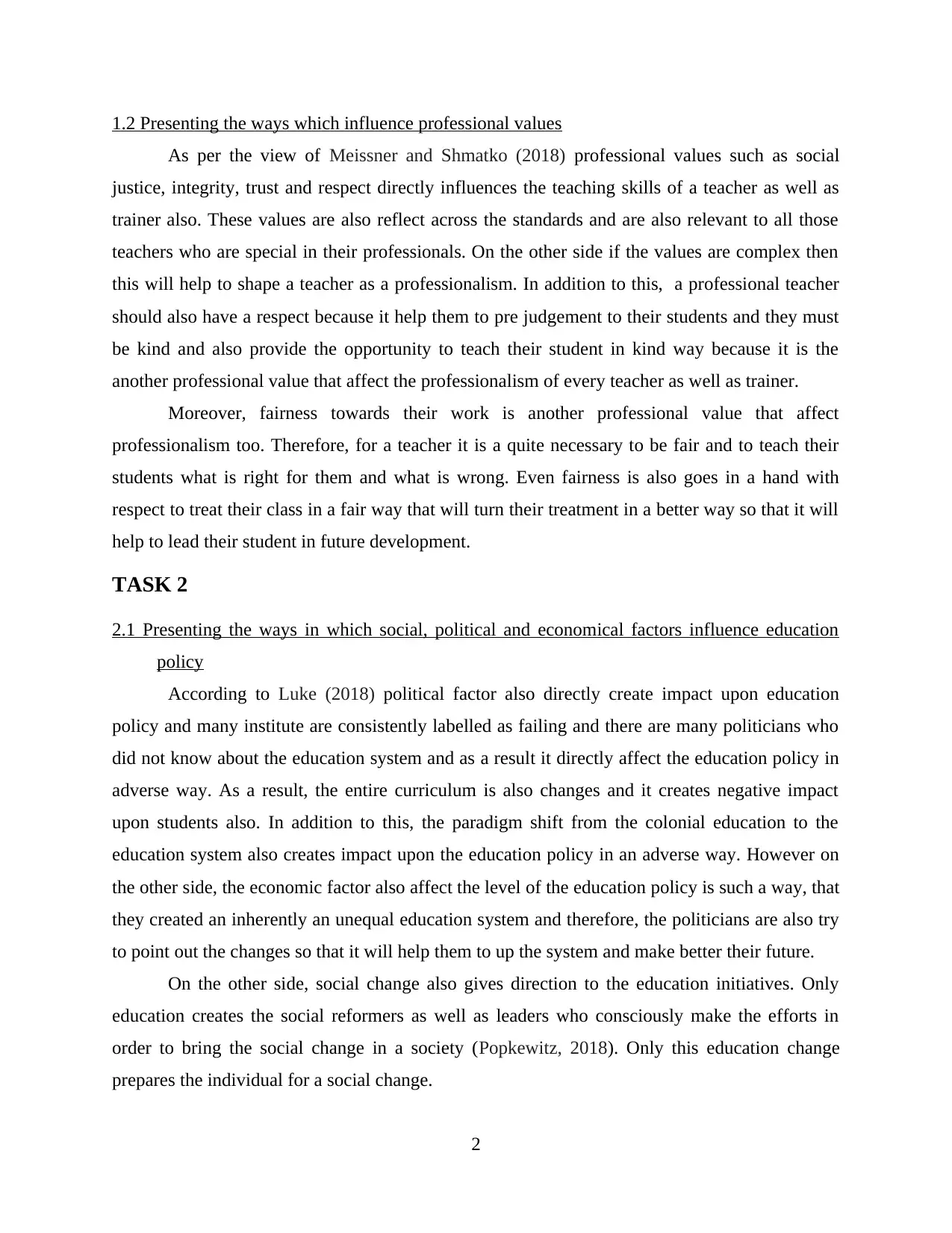
1.2 Presenting the ways which influence professional values
As per the view of Meissner and Shmatko (2018) professional values such as social
justice, integrity, trust and respect directly influences the teaching skills of a teacher as well as
trainer also. These values are also reflect across the standards and are also relevant to all those
teachers who are special in their professionals. On the other side if the values are complex then
this will help to shape a teacher as a professionalism. In addition to this, a professional teacher
should also have a respect because it help them to pre judgement to their students and they must
be kind and also provide the opportunity to teach their student in kind way because it is the
another professional value that affect the professionalism of every teacher as well as trainer.
Moreover, fairness towards their work is another professional value that affect
professionalism too. Therefore, for a teacher it is a quite necessary to be fair and to teach their
students what is right for them and what is wrong. Even fairness is also goes in a hand with
respect to treat their class in a fair way that will turn their treatment in a better way so that it will
help to lead their student in future development.
TASK 2
2.1 Presenting the ways in which social, political and economical factors influence education
policy
According to Luke (2018) political factor also directly create impact upon education
policy and many institute are consistently labelled as failing and there are many politicians who
did not know about the education system and as a result it directly affect the education policy in
adverse way. As a result, the entire curriculum is also changes and it creates negative impact
upon students also. In addition to this, the paradigm shift from the colonial education to the
education system also creates impact upon the education policy in an adverse way. However on
the other side, the economic factor also affect the level of the education policy is such a way, that
they created an inherently an unequal education system and therefore, the politicians are also try
to point out the changes so that it will help them to up the system and make better their future.
On the other side, social change also gives direction to the education initiatives. Only
education creates the social reformers as well as leaders who consciously make the efforts in
order to bring the social change in a society (Popkewitz, 2018). Only this education change
prepares the individual for a social change.
2
As per the view of Meissner and Shmatko (2018) professional values such as social
justice, integrity, trust and respect directly influences the teaching skills of a teacher as well as
trainer also. These values are also reflect across the standards and are also relevant to all those
teachers who are special in their professionals. On the other side if the values are complex then
this will help to shape a teacher as a professionalism. In addition to this, a professional teacher
should also have a respect because it help them to pre judgement to their students and they must
be kind and also provide the opportunity to teach their student in kind way because it is the
another professional value that affect the professionalism of every teacher as well as trainer.
Moreover, fairness towards their work is another professional value that affect
professionalism too. Therefore, for a teacher it is a quite necessary to be fair and to teach their
students what is right for them and what is wrong. Even fairness is also goes in a hand with
respect to treat their class in a fair way that will turn their treatment in a better way so that it will
help to lead their student in future development.
TASK 2
2.1 Presenting the ways in which social, political and economical factors influence education
policy
According to Luke (2018) political factor also directly create impact upon education
policy and many institute are consistently labelled as failing and there are many politicians who
did not know about the education system and as a result it directly affect the education policy in
adverse way. As a result, the entire curriculum is also changes and it creates negative impact
upon students also. In addition to this, the paradigm shift from the colonial education to the
education system also creates impact upon the education policy in an adverse way. However on
the other side, the economic factor also affect the level of the education policy is such a way, that
they created an inherently an unequal education system and therefore, the politicians are also try
to point out the changes so that it will help them to up the system and make better their future.
On the other side, social change also gives direction to the education initiatives. Only
education creates the social reformers as well as leaders who consciously make the efforts in
order to bring the social change in a society (Popkewitz, 2018). Only this education change
prepares the individual for a social change.
2
Secure Best Marks with AI Grader
Need help grading? Try our AI Grader for instant feedback on your assignments.
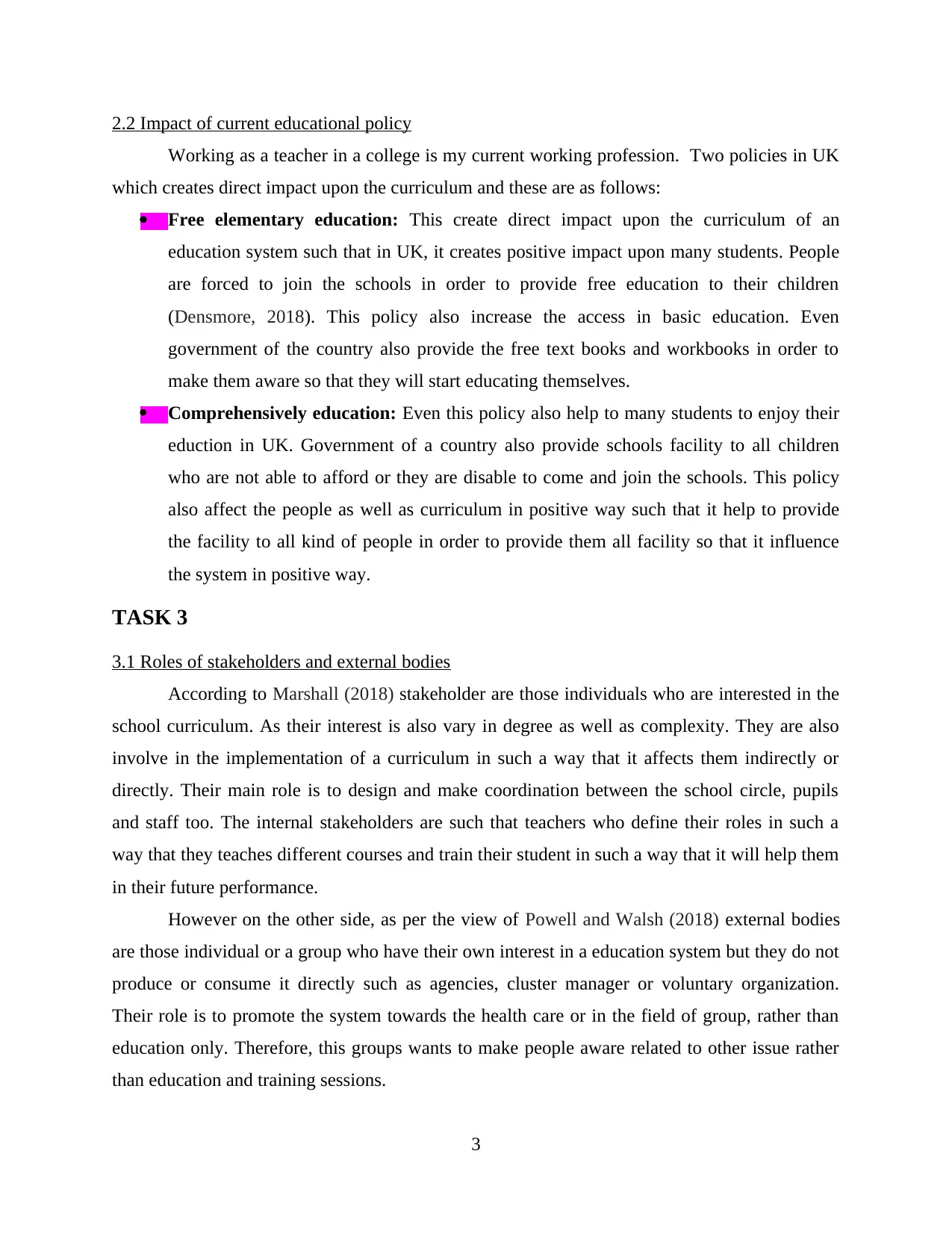
2.2 Impact of current educational policy
Working as a teacher in a college is my current working profession. Two policies in UK
which creates direct impact upon the curriculum and these are as follows:
Free elementary education: This create direct impact upon the curriculum of an
education system such that in UK, it creates positive impact upon many students. People
are forced to join the schools in order to provide free education to their children
(Densmore, 2018). This policy also increase the access in basic education. Even
government of the country also provide the free text books and workbooks in order to
make them aware so that they will start educating themselves.
Comprehensively education: Even this policy also help to many students to enjoy their
eduction in UK. Government of a country also provide schools facility to all children
who are not able to afford or they are disable to come and join the schools. This policy
also affect the people as well as curriculum in positive way such that it help to provide
the facility to all kind of people in order to provide them all facility so that it influence
the system in positive way.
TASK 3
3.1 Roles of stakeholders and external bodies
According to Marshall (2018) stakeholder are those individuals who are interested in the
school curriculum. As their interest is also vary in degree as well as complexity. They are also
involve in the implementation of a curriculum in such a way that it affects them indirectly or
directly. Their main role is to design and make coordination between the school circle, pupils
and staff too. The internal stakeholders are such that teachers who define their roles in such a
way that they teaches different courses and train their student in such a way that it will help them
in their future performance.
However on the other side, as per the view of Powell and Walsh (2018) external bodies
are those individual or a group who have their own interest in a education system but they do not
produce or consume it directly such as agencies, cluster manager or voluntary organization.
Their role is to promote the system towards the health care or in the field of group, rather than
education only. Therefore, this groups wants to make people aware related to other issue rather
than education and training sessions.
3
Working as a teacher in a college is my current working profession. Two policies in UK
which creates direct impact upon the curriculum and these are as follows:
Free elementary education: This create direct impact upon the curriculum of an
education system such that in UK, it creates positive impact upon many students. People
are forced to join the schools in order to provide free education to their children
(Densmore, 2018). This policy also increase the access in basic education. Even
government of the country also provide the free text books and workbooks in order to
make them aware so that they will start educating themselves.
Comprehensively education: Even this policy also help to many students to enjoy their
eduction in UK. Government of a country also provide schools facility to all children
who are not able to afford or they are disable to come and join the schools. This policy
also affect the people as well as curriculum in positive way such that it help to provide
the facility to all kind of people in order to provide them all facility so that it influence
the system in positive way.
TASK 3
3.1 Roles of stakeholders and external bodies
According to Marshall (2018) stakeholder are those individuals who are interested in the
school curriculum. As their interest is also vary in degree as well as complexity. They are also
involve in the implementation of a curriculum in such a way that it affects them indirectly or
directly. Their main role is to design and make coordination between the school circle, pupils
and staff too. The internal stakeholders are such that teachers who define their roles in such a
way that they teaches different courses and train their student in such a way that it will help them
in their future performance.
However on the other side, as per the view of Powell and Walsh (2018) external bodies
are those individual or a group who have their own interest in a education system but they do not
produce or consume it directly such as agencies, cluster manager or voluntary organization.
Their role is to promote the system towards the health care or in the field of group, rather than
education only. Therefore, this groups wants to make people aware related to other issue rather
than education and training sessions.
3
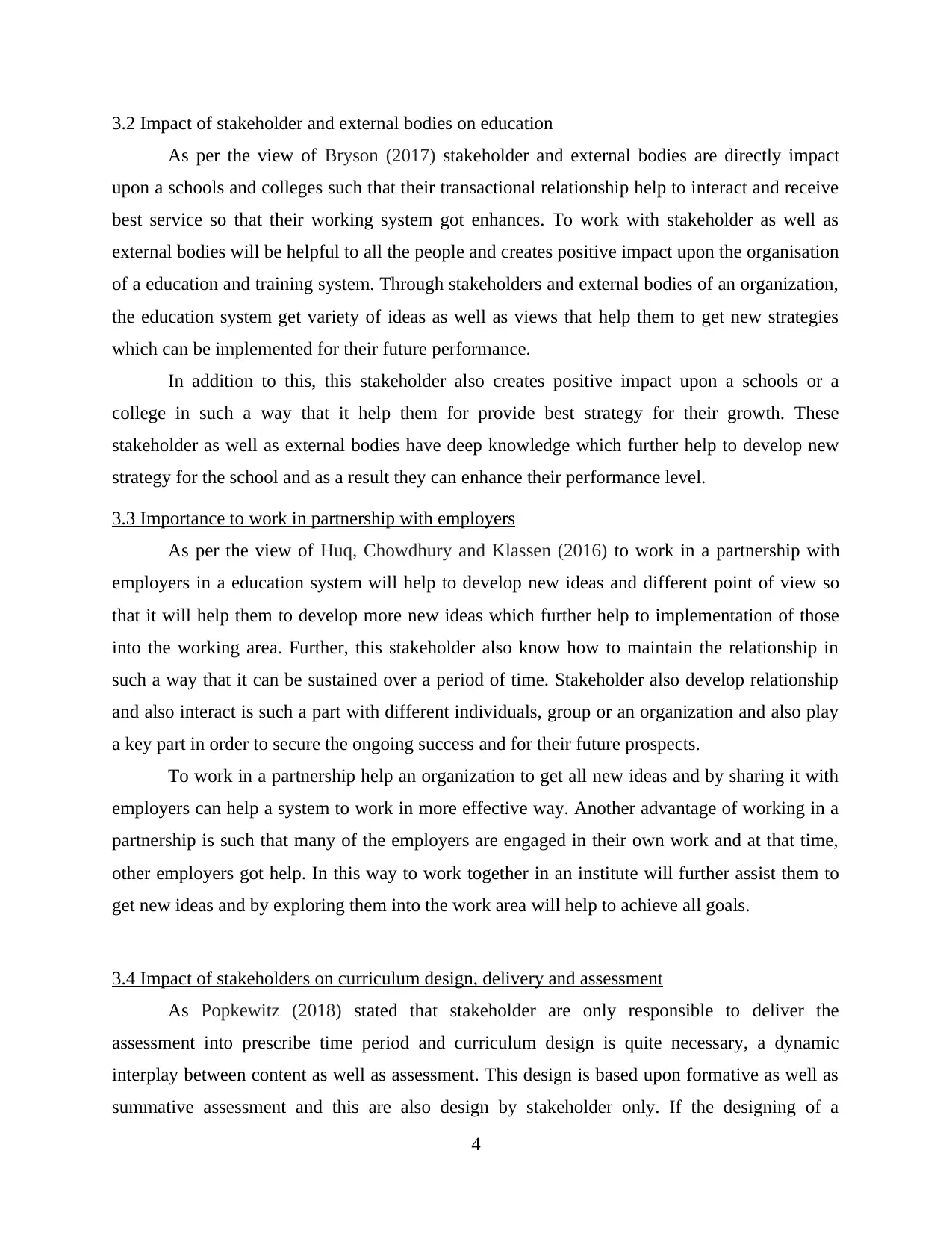
3.2 Impact of stakeholder and external bodies on education
As per the view of Bryson (2017) stakeholder and external bodies are directly impact
upon a schools and colleges such that their transactional relationship help to interact and receive
best service so that their working system got enhances. To work with stakeholder as well as
external bodies will be helpful to all the people and creates positive impact upon the organisation
of a education and training system. Through stakeholders and external bodies of an organization,
the education system get variety of ideas as well as views that help them to get new strategies
which can be implemented for their future performance.
In addition to this, this stakeholder also creates positive impact upon a schools or a
college in such a way that it help them for provide best strategy for their growth. These
stakeholder as well as external bodies have deep knowledge which further help to develop new
strategy for the school and as a result they can enhance their performance level.
3.3 Importance to work in partnership with employers
As per the view of Huq, Chowdhury and Klassen (2016) to work in a partnership with
employers in a education system will help to develop new ideas and different point of view so
that it will help them to develop more new ideas which further help to implementation of those
into the working area. Further, this stakeholder also know how to maintain the relationship in
such a way that it can be sustained over a period of time. Stakeholder also develop relationship
and also interact is such a part with different individuals, group or an organization and also play
a key part in order to secure the ongoing success and for their future prospects.
To work in a partnership help an organization to get all new ideas and by sharing it with
employers can help a system to work in more effective way. Another advantage of working in a
partnership is such that many of the employers are engaged in their own work and at that time,
other employers got help. In this way to work together in an institute will further assist them to
get new ideas and by exploring them into the work area will help to achieve all goals.
3.4 Impact of stakeholders on curriculum design, delivery and assessment
As Popkewitz (2018) stated that stakeholder are only responsible to deliver the
assessment into prescribe time period and curriculum design is quite necessary, a dynamic
interplay between content as well as assessment. This design is based upon formative as well as
summative assessment and this are also design by stakeholder only. If the designing of a
4
As per the view of Bryson (2017) stakeholder and external bodies are directly impact
upon a schools and colleges such that their transactional relationship help to interact and receive
best service so that their working system got enhances. To work with stakeholder as well as
external bodies will be helpful to all the people and creates positive impact upon the organisation
of a education and training system. Through stakeholders and external bodies of an organization,
the education system get variety of ideas as well as views that help them to get new strategies
which can be implemented for their future performance.
In addition to this, this stakeholder also creates positive impact upon a schools or a
college in such a way that it help them for provide best strategy for their growth. These
stakeholder as well as external bodies have deep knowledge which further help to develop new
strategy for the school and as a result they can enhance their performance level.
3.3 Importance to work in partnership with employers
As per the view of Huq, Chowdhury and Klassen (2016) to work in a partnership with
employers in a education system will help to develop new ideas and different point of view so
that it will help them to develop more new ideas which further help to implementation of those
into the working area. Further, this stakeholder also know how to maintain the relationship in
such a way that it can be sustained over a period of time. Stakeholder also develop relationship
and also interact is such a part with different individuals, group or an organization and also play
a key part in order to secure the ongoing success and for their future prospects.
To work in a partnership help an organization to get all new ideas and by sharing it with
employers can help a system to work in more effective way. Another advantage of working in a
partnership is such that many of the employers are engaged in their own work and at that time,
other employers got help. In this way to work together in an institute will further assist them to
get new ideas and by exploring them into the work area will help to achieve all goals.
3.4 Impact of stakeholders on curriculum design, delivery and assessment
As Popkewitz (2018) stated that stakeholder are only responsible to deliver the
assessment into prescribe time period and curriculum design is quite necessary, a dynamic
interplay between content as well as assessment. This design is based upon formative as well as
summative assessment and this are also design by stakeholder only. If the designing of a
4
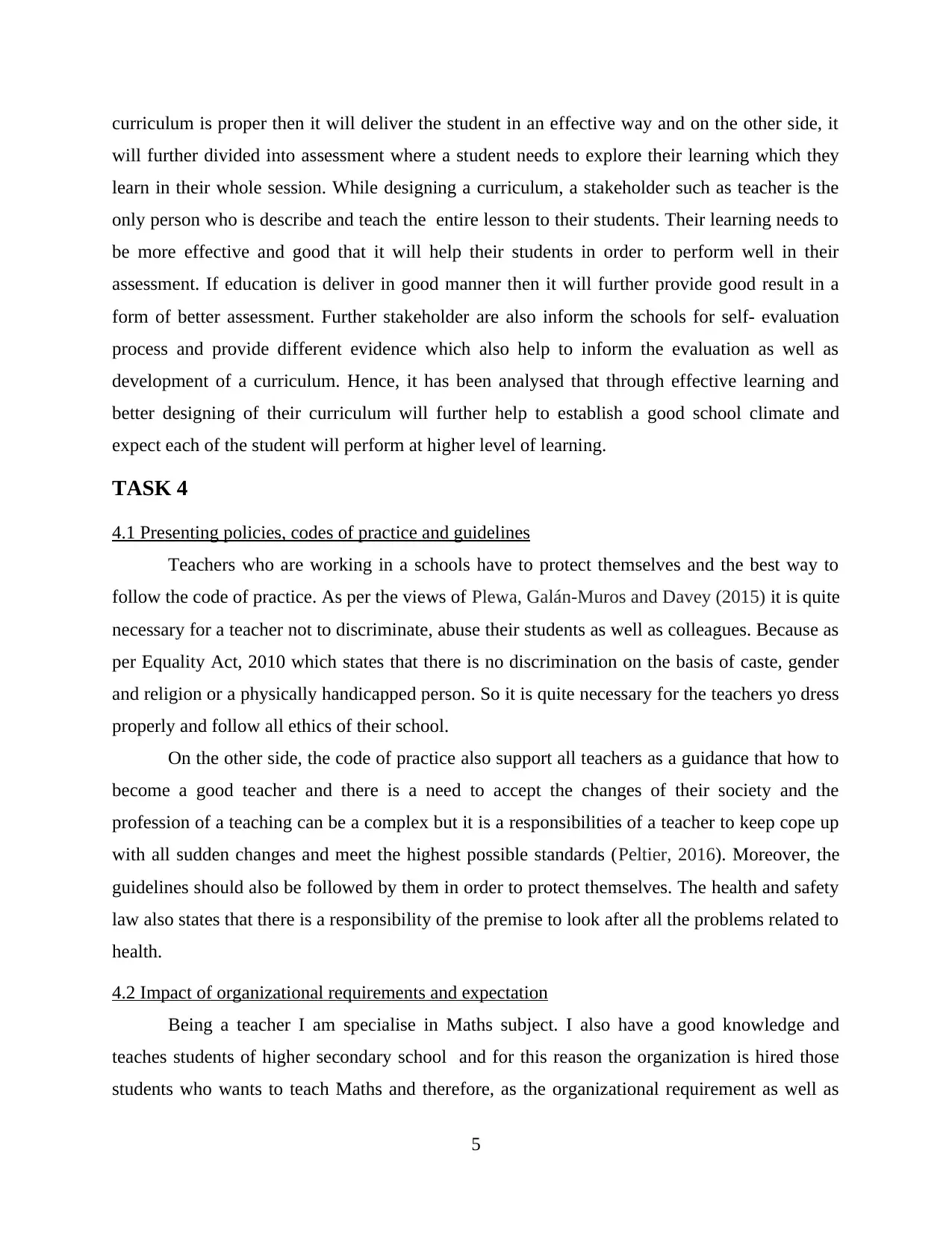
curriculum is proper then it will deliver the student in an effective way and on the other side, it
will further divided into assessment where a student needs to explore their learning which they
learn in their whole session. While designing a curriculum, a stakeholder such as teacher is the
only person who is describe and teach the entire lesson to their students. Their learning needs to
be more effective and good that it will help their students in order to perform well in their
assessment. If education is deliver in good manner then it will further provide good result in a
form of better assessment. Further stakeholder are also inform the schools for self- evaluation
process and provide different evidence which also help to inform the evaluation as well as
development of a curriculum. Hence, it has been analysed that through effective learning and
better designing of their curriculum will further help to establish a good school climate and
expect each of the student will perform at higher level of learning.
TASK 4
4.1 Presenting policies, codes of practice and guidelines
Teachers who are working in a schools have to protect themselves and the best way to
follow the code of practice. As per the views of Plewa, Galán-Muros and Davey (2015) it is quite
necessary for a teacher not to discriminate, abuse their students as well as colleagues. Because as
per Equality Act, 2010 which states that there is no discrimination on the basis of caste, gender
and religion or a physically handicapped person. So it is quite necessary for the teachers yo dress
properly and follow all ethics of their school.
On the other side, the code of practice also support all teachers as a guidance that how to
become a good teacher and there is a need to accept the changes of their society and the
profession of a teaching can be a complex but it is a responsibilities of a teacher to keep cope up
with all sudden changes and meet the highest possible standards (Peltier, 2016). Moreover, the
guidelines should also be followed by them in order to protect themselves. The health and safety
law also states that there is a responsibility of the premise to look after all the problems related to
health.
4.2 Impact of organizational requirements and expectation
Being a teacher I am specialise in Maths subject. I also have a good knowledge and
teaches students of higher secondary school and for this reason the organization is hired those
students who wants to teach Maths and therefore, as the organizational requirement as well as
5
will further divided into assessment where a student needs to explore their learning which they
learn in their whole session. While designing a curriculum, a stakeholder such as teacher is the
only person who is describe and teach the entire lesson to their students. Their learning needs to
be more effective and good that it will help their students in order to perform well in their
assessment. If education is deliver in good manner then it will further provide good result in a
form of better assessment. Further stakeholder are also inform the schools for self- evaluation
process and provide different evidence which also help to inform the evaluation as well as
development of a curriculum. Hence, it has been analysed that through effective learning and
better designing of their curriculum will further help to establish a good school climate and
expect each of the student will perform at higher level of learning.
TASK 4
4.1 Presenting policies, codes of practice and guidelines
Teachers who are working in a schools have to protect themselves and the best way to
follow the code of practice. As per the views of Plewa, Galán-Muros and Davey (2015) it is quite
necessary for a teacher not to discriminate, abuse their students as well as colleagues. Because as
per Equality Act, 2010 which states that there is no discrimination on the basis of caste, gender
and religion or a physically handicapped person. So it is quite necessary for the teachers yo dress
properly and follow all ethics of their school.
On the other side, the code of practice also support all teachers as a guidance that how to
become a good teacher and there is a need to accept the changes of their society and the
profession of a teaching can be a complex but it is a responsibilities of a teacher to keep cope up
with all sudden changes and meet the highest possible standards (Peltier, 2016). Moreover, the
guidelines should also be followed by them in order to protect themselves. The health and safety
law also states that there is a responsibility of the premise to look after all the problems related to
health.
4.2 Impact of organizational requirements and expectation
Being a teacher I am specialise in Maths subject. I also have a good knowledge and
teaches students of higher secondary school and for this reason the organization is hired those
students who wants to teach Maths and therefore, as the organizational requirement as well as
5
Paraphrase This Document
Need a fresh take? Get an instant paraphrase of this document with our AI Paraphraser
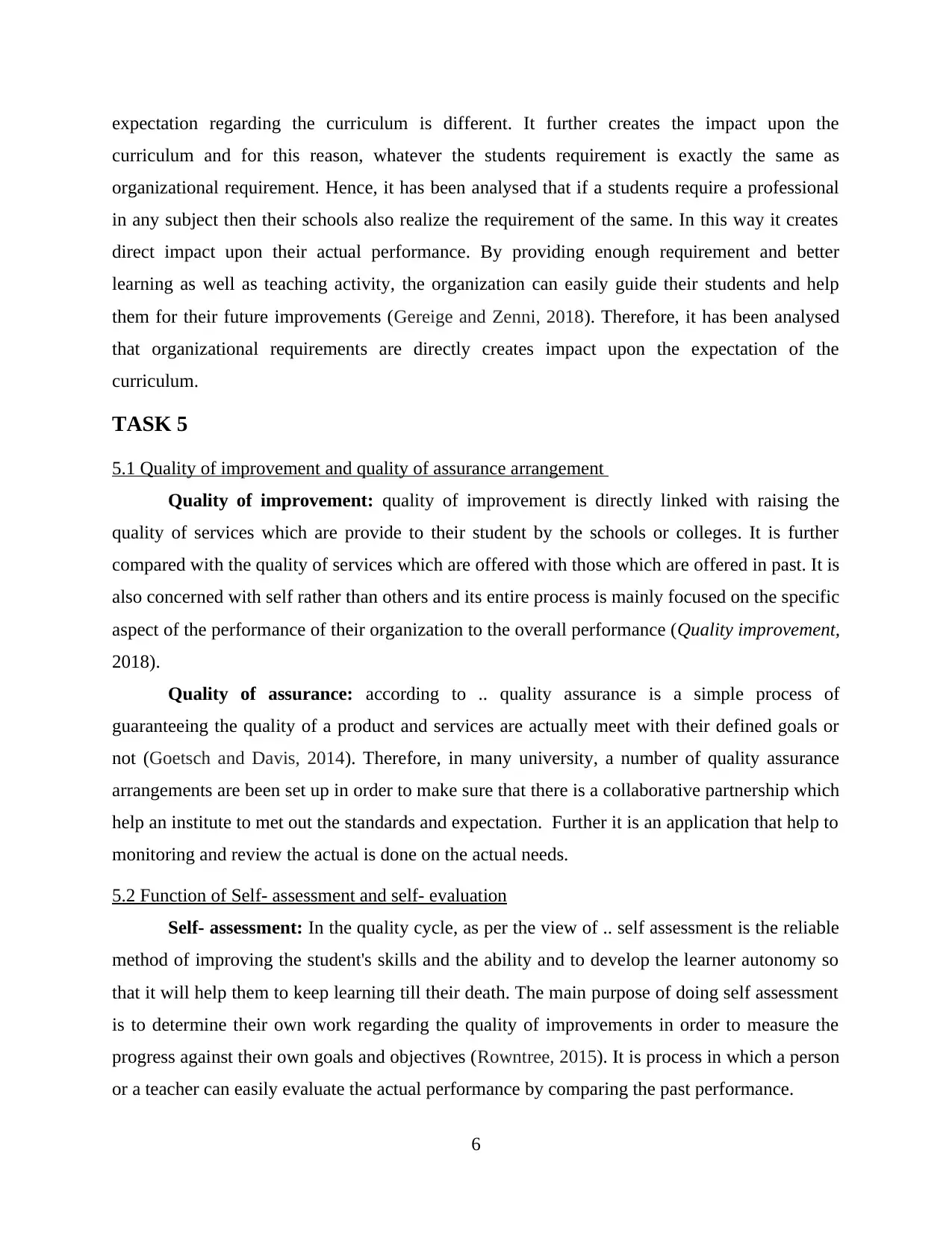
expectation regarding the curriculum is different. It further creates the impact upon the
curriculum and for this reason, whatever the students requirement is exactly the same as
organizational requirement. Hence, it has been analysed that if a students require a professional
in any subject then their schools also realize the requirement of the same. In this way it creates
direct impact upon their actual performance. By providing enough requirement and better
learning as well as teaching activity, the organization can easily guide their students and help
them for their future improvements (Gereige and Zenni, 2018). Therefore, it has been analysed
that organizational requirements are directly creates impact upon the expectation of the
curriculum.
TASK 5
5.1 Quality of improvement and quality of assurance arrangement
Quality of improvement: quality of improvement is directly linked with raising the
quality of services which are provide to their student by the schools or colleges. It is further
compared with the quality of services which are offered with those which are offered in past. It is
also concerned with self rather than others and its entire process is mainly focused on the specific
aspect of the performance of their organization to the overall performance (Quality improvement,
2018).
Quality of assurance: according to .. quality assurance is a simple process of
guaranteeing the quality of a product and services are actually meet with their defined goals or
not (Goetsch and Davis, 2014). Therefore, in many university, a number of quality assurance
arrangements are been set up in order to make sure that there is a collaborative partnership which
help an institute to met out the standards and expectation. Further it is an application that help to
monitoring and review the actual is done on the actual needs.
5.2 Function of Self- assessment and self- evaluation
Self- assessment: In the quality cycle, as per the view of .. self assessment is the reliable
method of improving the student's skills and the ability and to develop the learner autonomy so
that it will help them to keep learning till their death. The main purpose of doing self assessment
is to determine their own work regarding the quality of improvements in order to measure the
progress against their own goals and objectives (Rowntree, 2015). It is process in which a person
or a teacher can easily evaluate the actual performance by comparing the past performance.
6
curriculum and for this reason, whatever the students requirement is exactly the same as
organizational requirement. Hence, it has been analysed that if a students require a professional
in any subject then their schools also realize the requirement of the same. In this way it creates
direct impact upon their actual performance. By providing enough requirement and better
learning as well as teaching activity, the organization can easily guide their students and help
them for their future improvements (Gereige and Zenni, 2018). Therefore, it has been analysed
that organizational requirements are directly creates impact upon the expectation of the
curriculum.
TASK 5
5.1 Quality of improvement and quality of assurance arrangement
Quality of improvement: quality of improvement is directly linked with raising the
quality of services which are provide to their student by the schools or colleges. It is further
compared with the quality of services which are offered with those which are offered in past. It is
also concerned with self rather than others and its entire process is mainly focused on the specific
aspect of the performance of their organization to the overall performance (Quality improvement,
2018).
Quality of assurance: according to .. quality assurance is a simple process of
guaranteeing the quality of a product and services are actually meet with their defined goals or
not (Goetsch and Davis, 2014). Therefore, in many university, a number of quality assurance
arrangements are been set up in order to make sure that there is a collaborative partnership which
help an institute to met out the standards and expectation. Further it is an application that help to
monitoring and review the actual is done on the actual needs.
5.2 Function of Self- assessment and self- evaluation
Self- assessment: In the quality cycle, as per the view of .. self assessment is the reliable
method of improving the student's skills and the ability and to develop the learner autonomy so
that it will help them to keep learning till their death. The main purpose of doing self assessment
is to determine their own work regarding the quality of improvements in order to measure the
progress against their own goals and objectives (Rowntree, 2015). It is process in which a person
or a teacher can easily evaluate the actual performance by comparing the past performance.
6
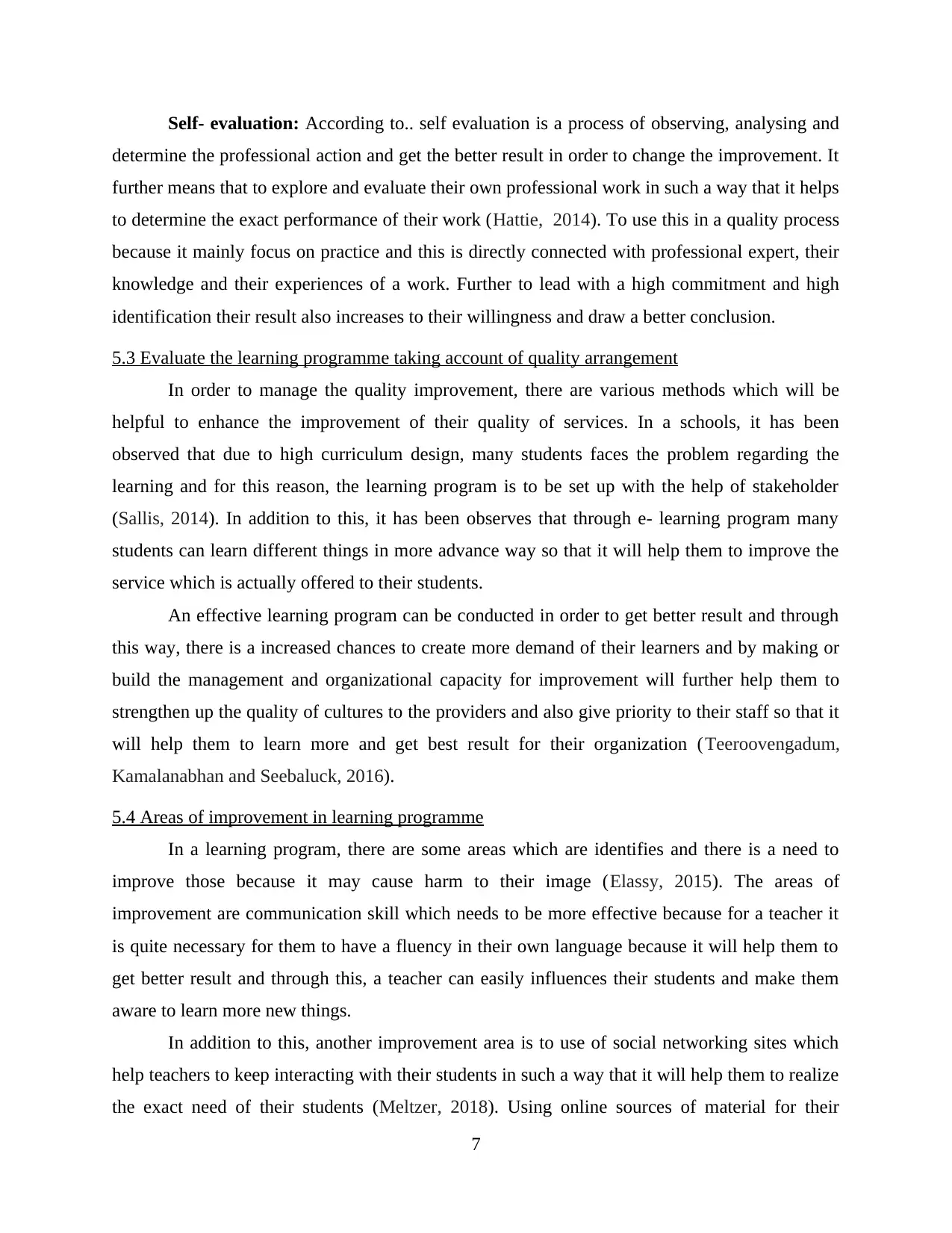
Self- evaluation: According to.. self evaluation is a process of observing, analysing and
determine the professional action and get the better result in order to change the improvement. It
further means that to explore and evaluate their own professional work in such a way that it helps
to determine the exact performance of their work (Hattie, 2014). To use this in a quality process
because it mainly focus on practice and this is directly connected with professional expert, their
knowledge and their experiences of a work. Further to lead with a high commitment and high
identification their result also increases to their willingness and draw a better conclusion.
5.3 Evaluate the learning programme taking account of quality arrangement
In order to manage the quality improvement, there are various methods which will be
helpful to enhance the improvement of their quality of services. In a schools, it has been
observed that due to high curriculum design, many students faces the problem regarding the
learning and for this reason, the learning program is to be set up with the help of stakeholder
(Sallis, 2014). In addition to this, it has been observes that through e- learning program many
students can learn different things in more advance way so that it will help them to improve the
service which is actually offered to their students.
An effective learning program can be conducted in order to get better result and through
this way, there is a increased chances to create more demand of their learners and by making or
build the management and organizational capacity for improvement will further help them to
strengthen up the quality of cultures to the providers and also give priority to their staff so that it
will help them to learn more and get best result for their organization (Teeroovengadum,
Kamalanabhan and Seebaluck, 2016).
5.4 Areas of improvement in learning programme
In a learning program, there are some areas which are identifies and there is a need to
improve those because it may cause harm to their image (Elassy, 2015). The areas of
improvement are communication skill which needs to be more effective because for a teacher it
is quite necessary for them to have a fluency in their own language because it will help them to
get better result and through this, a teacher can easily influences their students and make them
aware to learn more new things.
In addition to this, another improvement area is to use of social networking sites which
help teachers to keep interacting with their students in such a way that it will help them to realize
the exact need of their students (Meltzer, 2018). Using online sources of material for their
7
determine the professional action and get the better result in order to change the improvement. It
further means that to explore and evaluate their own professional work in such a way that it helps
to determine the exact performance of their work (Hattie, 2014). To use this in a quality process
because it mainly focus on practice and this is directly connected with professional expert, their
knowledge and their experiences of a work. Further to lead with a high commitment and high
identification their result also increases to their willingness and draw a better conclusion.
5.3 Evaluate the learning programme taking account of quality arrangement
In order to manage the quality improvement, there are various methods which will be
helpful to enhance the improvement of their quality of services. In a schools, it has been
observed that due to high curriculum design, many students faces the problem regarding the
learning and for this reason, the learning program is to be set up with the help of stakeholder
(Sallis, 2014). In addition to this, it has been observes that through e- learning program many
students can learn different things in more advance way so that it will help them to improve the
service which is actually offered to their students.
An effective learning program can be conducted in order to get better result and through
this way, there is a increased chances to create more demand of their learners and by making or
build the management and organizational capacity for improvement will further help them to
strengthen up the quality of cultures to the providers and also give priority to their staff so that it
will help them to learn more and get best result for their organization (Teeroovengadum,
Kamalanabhan and Seebaluck, 2016).
5.4 Areas of improvement in learning programme
In a learning program, there are some areas which are identifies and there is a need to
improve those because it may cause harm to their image (Elassy, 2015). The areas of
improvement are communication skill which needs to be more effective because for a teacher it
is quite necessary for them to have a fluency in their own language because it will help them to
get better result and through this, a teacher can easily influences their students and make them
aware to learn more new things.
In addition to this, another improvement area is to use of social networking sites which
help teachers to keep interacting with their students in such a way that it will help them to realize
the exact need of their students (Meltzer, 2018). Using online sources of material for their
7
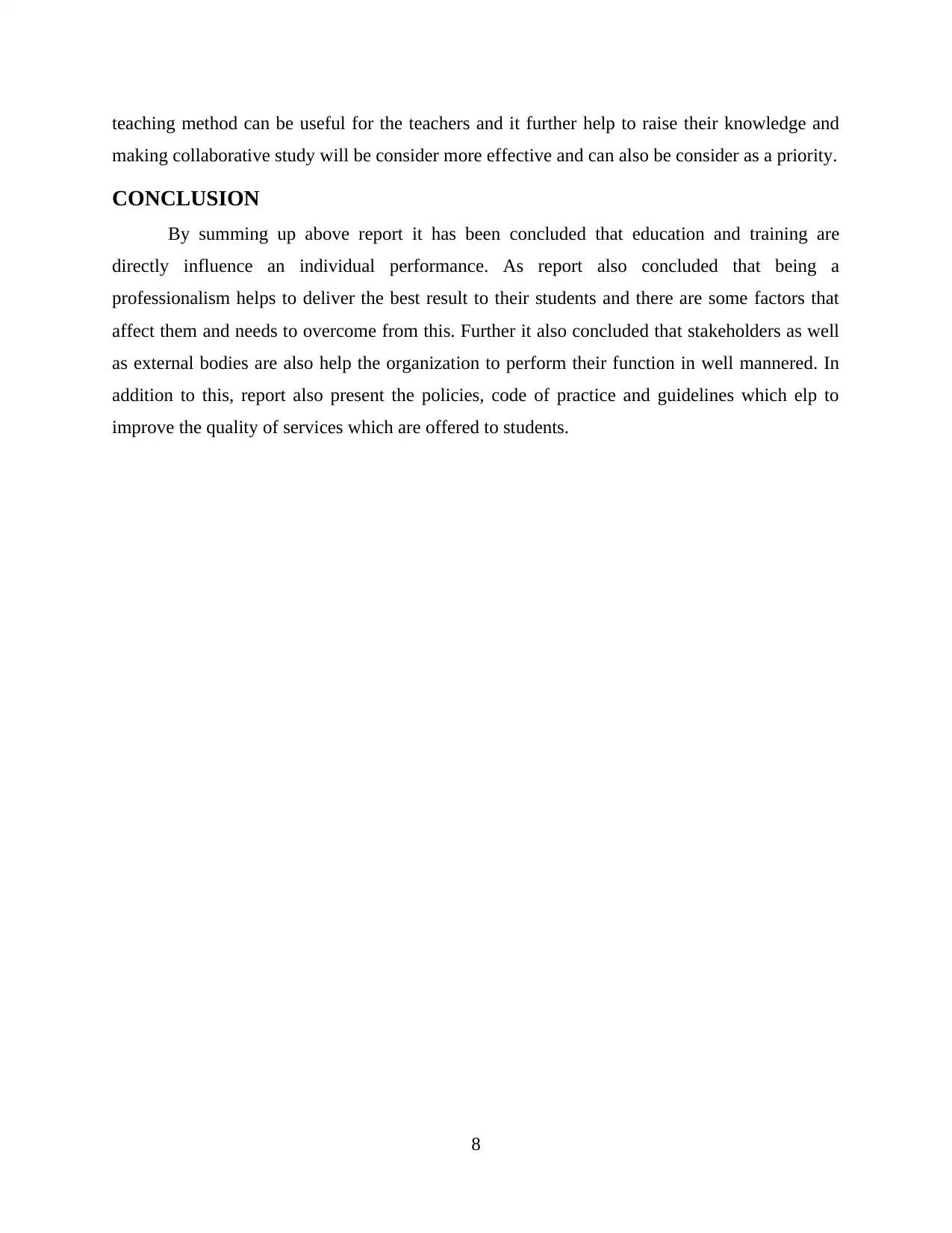
teaching method can be useful for the teachers and it further help to raise their knowledge and
making collaborative study will be consider more effective and can also be consider as a priority.
CONCLUSION
By summing up above report it has been concluded that education and training are
directly influence an individual performance. As report also concluded that being a
professionalism helps to deliver the best result to their students and there are some factors that
affect them and needs to overcome from this. Further it also concluded that stakeholders as well
as external bodies are also help the organization to perform their function in well mannered. In
addition to this, report also present the policies, code of practice and guidelines which elp to
improve the quality of services which are offered to students.
8
making collaborative study will be consider more effective and can also be consider as a priority.
CONCLUSION
By summing up above report it has been concluded that education and training are
directly influence an individual performance. As report also concluded that being a
professionalism helps to deliver the best result to their students and there are some factors that
affect them and needs to overcome from this. Further it also concluded that stakeholders as well
as external bodies are also help the organization to perform their function in well mannered. In
addition to this, report also present the policies, code of practice and guidelines which elp to
improve the quality of services which are offered to students.
8
Secure Best Marks with AI Grader
Need help grading? Try our AI Grader for instant feedback on your assignments.
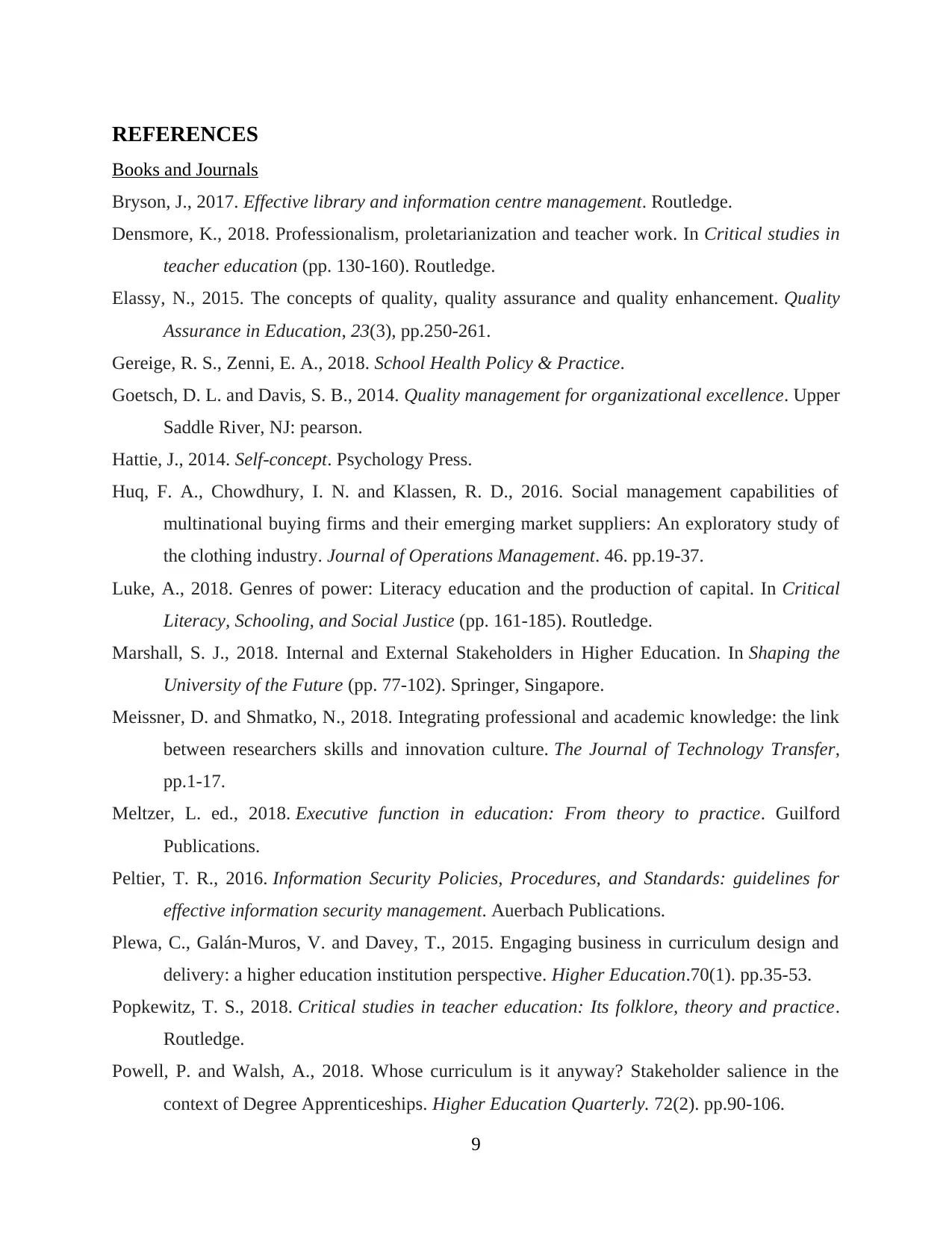
REFERENCES
Books and Journals
Bryson, J., 2017. Effective library and information centre management. Routledge.
Densmore, K., 2018. Professionalism, proletarianization and teacher work. In Critical studies in
teacher education (pp. 130-160). Routledge.
Elassy, N., 2015. The concepts of quality, quality assurance and quality enhancement. Quality
Assurance in Education, 23(3), pp.250-261.
Gereige, R. S., Zenni, E. A., 2018. School Health Policy & Practice.
Goetsch, D. L. and Davis, S. B., 2014. Quality management for organizational excellence. Upper
Saddle River, NJ: pearson.
Hattie, J., 2014. Self-concept. Psychology Press.
Huq, F. A., Chowdhury, I. N. and Klassen, R. D., 2016. Social management capabilities of
multinational buying firms and their emerging market suppliers: An exploratory study of
the clothing industry. Journal of Operations Management. 46. pp.19-37.
Luke, A., 2018. Genres of power: Literacy education and the production of capital. In Critical
Literacy, Schooling, and Social Justice (pp. 161-185). Routledge.
Marshall, S. J., 2018. Internal and External Stakeholders in Higher Education. In Shaping the
University of the Future (pp. 77-102). Springer, Singapore.
Meissner, D. and Shmatko, N., 2018. Integrating professional and academic knowledge: the link
between researchers skills and innovation culture. The Journal of Technology Transfer,
pp.1-17.
Meltzer, L. ed., 2018. Executive function in education: From theory to practice. Guilford
Publications.
Peltier, T. R., 2016. Information Security Policies, Procedures, and Standards: guidelines for
effective information security management. Auerbach Publications.
Plewa, C., Galán-Muros, V. and Davey, T., 2015. Engaging business in curriculum design and
delivery: a higher education institution perspective. Higher Education.70(1). pp.35-53.
Popkewitz, T. S., 2018. Critical studies in teacher education: Its folklore, theory and practice.
Routledge.
Powell, P. and Walsh, A., 2018. Whose curriculum is it anyway? Stakeholder salience in the
context of Degree Apprenticeships. Higher Education Quarterly. 72(2). pp.90-106.
9
Books and Journals
Bryson, J., 2017. Effective library and information centre management. Routledge.
Densmore, K., 2018. Professionalism, proletarianization and teacher work. In Critical studies in
teacher education (pp. 130-160). Routledge.
Elassy, N., 2015. The concepts of quality, quality assurance and quality enhancement. Quality
Assurance in Education, 23(3), pp.250-261.
Gereige, R. S., Zenni, E. A., 2018. School Health Policy & Practice.
Goetsch, D. L. and Davis, S. B., 2014. Quality management for organizational excellence. Upper
Saddle River, NJ: pearson.
Hattie, J., 2014. Self-concept. Psychology Press.
Huq, F. A., Chowdhury, I. N. and Klassen, R. D., 2016. Social management capabilities of
multinational buying firms and their emerging market suppliers: An exploratory study of
the clothing industry. Journal of Operations Management. 46. pp.19-37.
Luke, A., 2018. Genres of power: Literacy education and the production of capital. In Critical
Literacy, Schooling, and Social Justice (pp. 161-185). Routledge.
Marshall, S. J., 2018. Internal and External Stakeholders in Higher Education. In Shaping the
University of the Future (pp. 77-102). Springer, Singapore.
Meissner, D. and Shmatko, N., 2018. Integrating professional and academic knowledge: the link
between researchers skills and innovation culture. The Journal of Technology Transfer,
pp.1-17.
Meltzer, L. ed., 2018. Executive function in education: From theory to practice. Guilford
Publications.
Peltier, T. R., 2016. Information Security Policies, Procedures, and Standards: guidelines for
effective information security management. Auerbach Publications.
Plewa, C., Galán-Muros, V. and Davey, T., 2015. Engaging business in curriculum design and
delivery: a higher education institution perspective. Higher Education.70(1). pp.35-53.
Popkewitz, T. S., 2018. Critical studies in teacher education: Its folklore, theory and practice.
Routledge.
Powell, P. and Walsh, A., 2018. Whose curriculum is it anyway? Stakeholder salience in the
context of Degree Apprenticeships. Higher Education Quarterly. 72(2). pp.90-106.
9
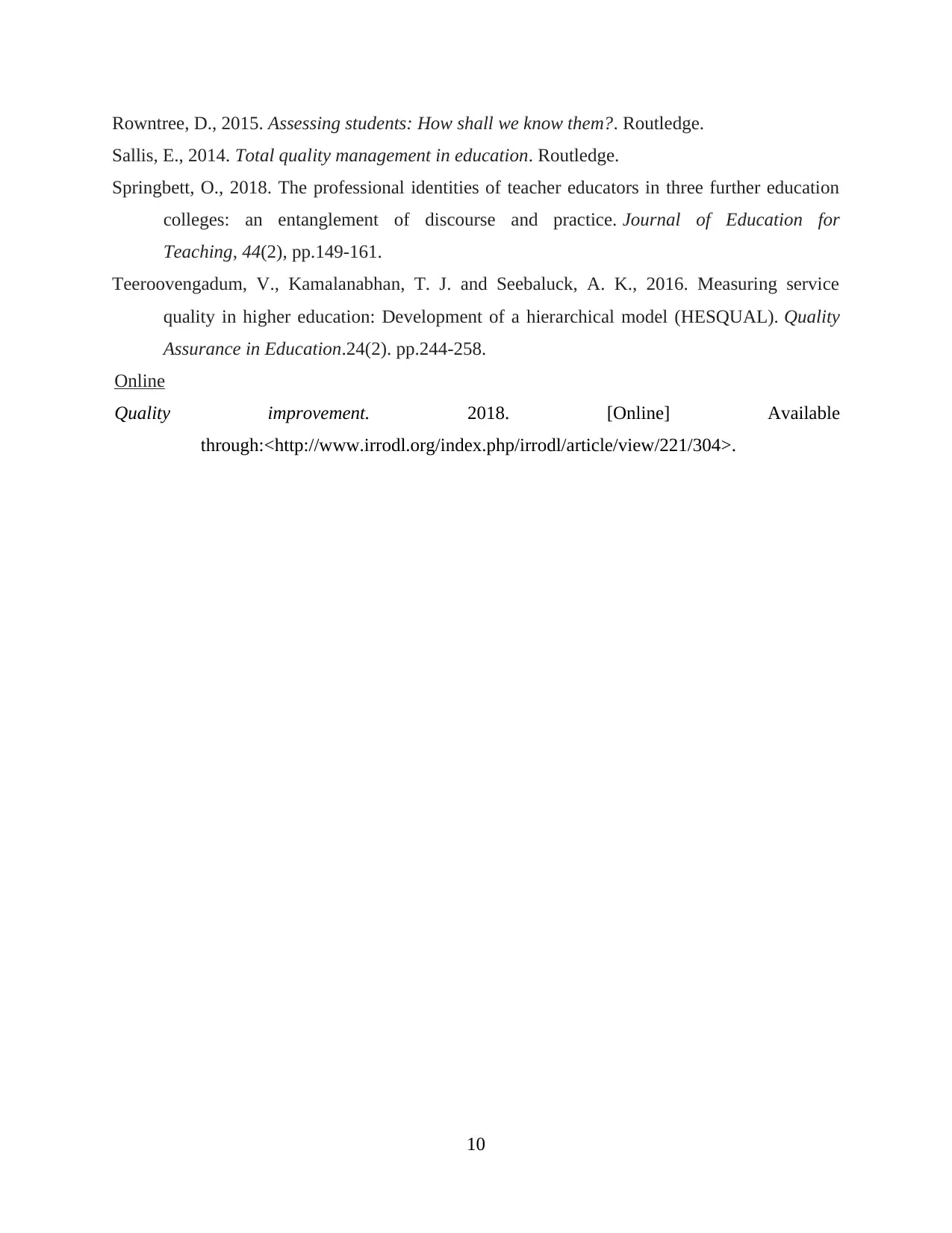
Rowntree, D., 2015. Assessing students: How shall we know them?. Routledge.
Sallis, E., 2014. Total quality management in education. Routledge.
Springbett, O., 2018. The professional identities of teacher educators in three further education
colleges: an entanglement of discourse and practice. Journal of Education for
Teaching, 44(2), pp.149-161.
Teeroovengadum, V., Kamalanabhan, T. J. and Seebaluck, A. K., 2016. Measuring service
quality in higher education: Development of a hierarchical model (HESQUAL). Quality
Assurance in Education.24(2). pp.244-258.
Online
Quality improvement. 2018. [Online] Available
through:<http://www.irrodl.org/index.php/irrodl/article/view/221/304>.
10
Sallis, E., 2014. Total quality management in education. Routledge.
Springbett, O., 2018. The professional identities of teacher educators in three further education
colleges: an entanglement of discourse and practice. Journal of Education for
Teaching, 44(2), pp.149-161.
Teeroovengadum, V., Kamalanabhan, T. J. and Seebaluck, A. K., 2016. Measuring service
quality in higher education: Development of a hierarchical model (HESQUAL). Quality
Assurance in Education.24(2). pp.244-258.
Online
Quality improvement. 2018. [Online] Available
through:<http://www.irrodl.org/index.php/irrodl/article/view/221/304>.
10
1 out of 12
Related Documents
Your All-in-One AI-Powered Toolkit for Academic Success.
+13062052269
info@desklib.com
Available 24*7 on WhatsApp / Email
![[object Object]](/_next/static/media/star-bottom.7253800d.svg)
Unlock your academic potential
© 2024 | Zucol Services PVT LTD | All rights reserved.


